Evolution and Analysis of Water Yield under the Change of Land Use and Climate Change Based on the PLUS-InVEST Model: A Case Study of the Yellow River Basin in Henan Province
Abstract
:1. Introduction
2. Study Area and Data Source
2.1. Study Area Overview
2.2. River Basin and River Systems
2.3. Data
2.3.1. Land Use Data
2.3.2. Meteorological Data
2.3.3. Topographic Data
2.3.4. Socio-Economic Data
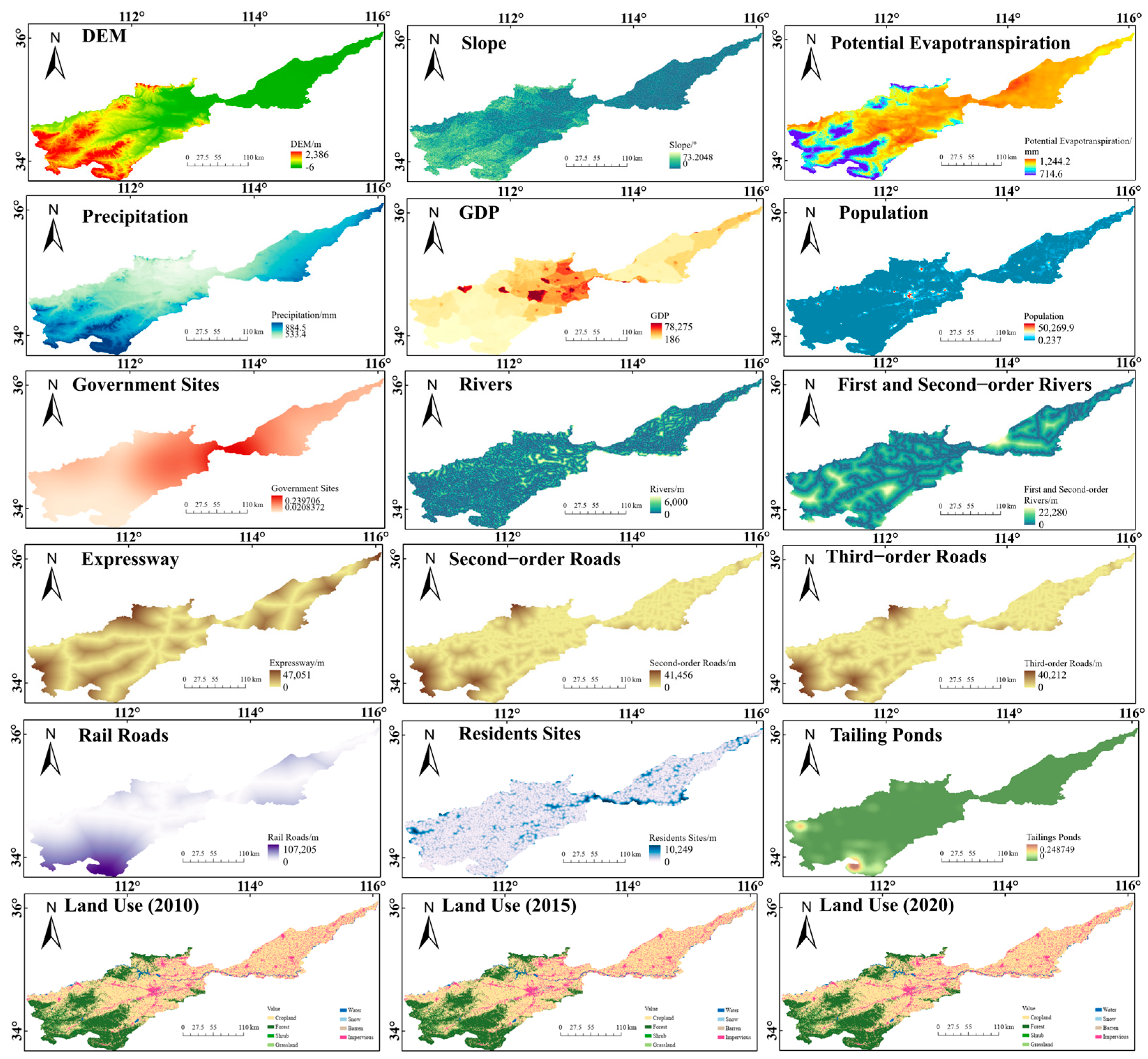
| Data Type | Name | Data Resolution/m | Source of Data |
|---|---|---|---|
| Land Use Data | Land Use | 30 | Pixel Information Expert Engine [43] |
| Meteorological data | Potential evapotranspiration (PET) | 1000 (resampling to 30 m) | National Tibetan Plateau Data Center/Third Pole Environment Data Center [46] |
| Precipitation (PRE) | 1000 | National Tibetan Plateau Data Center/Third Pole Environment Data Center [51] | |
| Topographic data | DEM elevation (DEM) | 30 | Aster GDEM v3 [52] |
| Slope (SLP) | 30 | Calculated by DEM using ArcGIS v10.8 to obtain | |
| Socio-economic data | GDP | 1000 (resampling to 30 m) | Pixel Information Expert Engine [53] |
| Population (POP) | 1000 (resampling to 30 m) | WorldPop [54] | |
| Distance to government (DG) | 30 (Euclidean distance) | National Catalogue Service For Geographic Information [55] | |
| Distance to rivers (DRI) | 30 (Euclidean distance) | ||
| Distance to first and second-order streams (DFSS) | 30 (Euclidean distance) | ||
| Distance to residents (DRE) | 30 (Euclidean distance) | ||
| Distance to expressway (DH) | 30 (Euclidean distance) | ||
| Distance to first-order roads (DFR) | 30 (Euclidean distance) | ||
| Distance to second-order roads (DSR) | 30 (Euclidean distance) | ||
| Distance to third-order roads (DTR) | 30 (Euclidean distance) | ||
| Distance to rial roads (DRR) | 30 (Euclidean distance) | ||
| Distance to tailings pond (DTP) | 30 (Euclidean distance) | Local environmental protection department |
3. Research Methodology
3.1. Methodology
3.2. Simulation and Calibration of Water Yield Based on InVEST Model
3.2.1. Water Yield Simulation Based on InVEST Model
3.2.2. Model Calibration
3.3. PLUS Model
3.3.1. LEAS (Land Expansion Analysis Strategy)
3.3.2. CARS (CA Based on Multiple Random Seeds)
3.3.3. PLUS Simulation Strategy and Scenarios Setting
3.4. Geodetector
4. Results
4.1. The Change of Land Use
4.1.1. Interannual Variation of Land Use
4.1.2. Driving Factor Contribution Degree
4.1.3. Land Use Forecasting
4.2. The Change of Water Yield
4.2.1. Interannual Variation of Water Yield
4.2.2. Water Yield under Different Scenarios
4.2.3. Geodetection of Water Yield
5. Discussion
5.1. Temporal and Spatial Transformation of Land Use
5.2. Temporal and Spatial Transformation of Water Yield
5.3. Limitations of This Research
6. Conclusions
Author Contributions
Funding
Data Availability Statement
Conflicts of Interest
References
- MEA. Millennium Ecosystem Assessment: Current State & Trends Assessment; Island Press: Washington, DC, USA, 2005. [Google Scholar]
- Shan, Y.; Dai, X.; Li, W.; Yang, Z.; Wang, Y.; Qu, G.; Liu, W.; Ren, J.; Li, C.; Liang, S. Detecting spatial-temporal changes of urban environment quality by remote sensing-based ecological indices: A case study in Panzhihua city, Sichuan Province, China. Remote Sens. 2022, 14, 4137. [Google Scholar] [CrossRef]
- Millennium Ecosystem Assessment. Ecosystems and Human Well-Being: Biodiversity Synthesis; World Resources Institute: Washington, DC, USA, 2005; Available online: https://www.researchgate.net/publication/269576188_Ecosystems_and_Human_Well-Being_Biodiversity_Synthesis (accessed on 16 July 2024).
- Guo, C.; Xu, H. Use of functional distinctness of periphytic ciliates for monitoring water quality in coastal ecosystems. Ecol. Indic. 2019, 96, 213–218. [Google Scholar] [CrossRef]
- Han, Z.; Li, B.; Han, Z.; Wang, S.; Peng, W.; Liu, X.; Benson, D. Dynamic Simulation of Land Use and Habitat Quality Assessment in Baiyangdian Basin Using the SD-PLUS Coupled Model. Water 2024, 16, 678. [Google Scholar] [CrossRef]
- Aznar-Sánchez, J.A.; Velasco-Muñoz, J.F.; Belmonte-Ureña, L.J.; Manzano-Agugliaro, F. The worldwide research trends on water ecosystem services. Ecol. Indic. 2019, 99, 310–323. [Google Scholar] [CrossRef]
- Díaz, M.E.; Figueroa, R.; Alonso, M.L.S.; Vidal-Abarca, M.R. Exploring the complex relations between water resources and social indicators: The Biobío Basin (Chile). Ecosyst. Serv. 2018, 31, 84–92. [Google Scholar] [CrossRef]
- Costanza, R.; d’Arge, R.; De Groot, R.; Farber, S.; Grasso, M.; Hannon, B.; Limburg, K.; Naeem, S.; O’neill, R.V.; Paruelo, J. The value of the world’s ecosystem services and natural capital. Nature 1997, 387, 253–260. [Google Scholar] [CrossRef]
- Chen, Y.; Xu, X.; Zhang, X.; Singh, V.P.; Li, M. Weather-driven synergistic water-economy-environment regulation of farmland ecosystems. Sci. Total Environ. 2023, 880, 163342. [Google Scholar] [CrossRef]
- Ragab, R.; Prudhomme, C. Sw—Soil and Water: Climate change and water resources management in arid and semi-arid regions: Prospective and challenges for the 21st century. Biosyst. Eng. 2002, 81, 3–34. [Google Scholar] [CrossRef]
- Bandyopadhyay, J. Water, Ecosystems and Society: A Confluence of Disciplines. Resour. Energy Dev. 2009, 6, 95–96. [Google Scholar]
- Pimentel, D.; Berger, B.; Filiberto, D.; Newton, M.; Wolfe, B.; Karabinakis, E.; Clark, S.; Poon, E.; Abbett, E.; Nandagopal, S. Water resources: Agricultural and environmental issues. BioScience 2004, 54, 909–918. [Google Scholar] [CrossRef]
- Chanapathi, T.; Thatikonda, S.; Raghavan, S. Analysis of rainfall extremes and water yield of Krishna river basin under future climate scenarios. J. Hydrol. Reg. Stud. 2018, 19, 287–306. [Google Scholar] [CrossRef]
- Belete, M.; Deng, J.; Wang, K.; Zhou, M.; Zhu, E.; Shifaw, E.; Bayissa, Y. Evaluation of satellite rainfall products for modeling water yield over the source region of Blue Nile Basin. Sci. Total Environ. 2020, 708, 134834. [Google Scholar] [CrossRef] [PubMed]
- Stednick, J.D. Monitoring the effects of timber harvest on annual water yield. J. Hydrol. 1996, 176, 79–95. [Google Scholar] [CrossRef]
- Yifru, B.A.; Chung, I.-M.; Kim, M.-G.; Chang, S.W. Assessing the effect of land/use land cover and climate change on water yield and groundwater recharge in East African Rift Valley using integrated model. J. Hydrol. Reg. Stud. 2021, 37, 100926. [Google Scholar] [CrossRef]
- Caldwell, P.V.; Miniat, C.F.; Elliott, K.J.; Swank, W.T.; Brantley, S.T.; Laseter, S.H. Declining water yield from forested mountain watersheds in response to climate change and forest mesophication. Glob. Chang. Biol. 2016, 22, 2997–3012. [Google Scholar] [CrossRef]
- Natalia, P.; Silvia, F.; Silvina, S.; Miguel, P. Climate change in northern Patagonia: Critical decrease in water resources. Theor. Appl. Climatol. 2020, 140, 807–822. [Google Scholar] [CrossRef]
- Hu, J.; Wu, Y.; Wang, L.; Sun, P.; Zhao, F.; Jin, Z.; Wang, Y.; Qiu, L.; Lian, Y. Impacts of land-use conversions on the water cycle in a typical watershed in the southern Chinese Loess Plateau. J. Hydrol. 2021, 593, 125741. [Google Scholar] [CrossRef]
- Ye, L.; Cheng, L.; Liu, P.; Liu, D.; Zhang, L.; Qin, S.; Xia, J. Management of vegetative land for more water yield under future climate conditions in the over-utilized water resources regions: A case study in the Xiong’an New area. J. Hydrol. 2021, 600, 126563. [Google Scholar] [CrossRef]
- Ercan, M.B.; Maghami, I.; Bowes, B.D.; Morsy, M.M.; Goodall, J.L. Estimating potential climate change effects on the upper neuse watershed water balance using the SWAT model. JAWRA J. Am. Water Resour. Assoc. 2020, 56, 53–67. [Google Scholar] [CrossRef]
- Ndhlovu, G.; Woyessa, Y. Modelling impact of climate change on catchment water balance, Kabompo River in Zambezi River Basin. J. Hydrol. Reg. Stud. 2020, 27, 100650. [Google Scholar] [CrossRef]
- Gomes, L.; Bianchi, F.; Cardoso, I.; Schulte, R.; Fernandes, R.; Fernandes-Filho, E. Disentangling the historic and future impacts of land use changes and climate variability on the hydrology of a mountain region in Brazil. J. Hydrol. 2021, 594, 125650. [Google Scholar] [CrossRef]
- Wang, Q.; Cheng, L.; Zhang, L.; Liu, P.; Qin, S.; Liu, L.; Jing, Z. Quantifying the impacts of land-cover changes on global evapotranspiration based on the continuous remote sensing observations during 1982–2016. J. Hydrol. 2021, 598, 126231. [Google Scholar] [CrossRef]
- Li, M.; Li, S.; Liu, H.; Zhang, J. Balancing Water Ecosystem Services: Assessing Water Yield and Purification in Shanxi. Water 2023, 15, 3261. [Google Scholar] [CrossRef]
- Yin, L.; Feng, X.; Fu, B.; Wang, S.; Wang, X.; Chen, Y.; Tao, F.; Hu, J. A coupled human-natural system analysis of water yield in the Yellow River basin, China. Sci. Total Environ. 2021, 762, 143141. [Google Scholar] [CrossRef]
- Abbott, B.W.; Bishop, K.; Zarnetske, J.P.; Minaudo, C.; Chapin, F.S., III; Krause, S.; Hannah, D.M.; Conner, L.; Ellison, D.; Godsey, S.E. Human domination of the global water cycle absent from depictions and perceptions. Nat. Geosci. 2019, 12, 533–540. [Google Scholar] [CrossRef]
- Reheman, R.; Kasimu, A.; Duolaiti, X.; Wei, B.; Zhao, Y. Research on the Change in Prediction of Water Production in Urban Agglomerations on the Northern Slopes of the Tianshan Mountains Based on the InVEST–PLUS Model. Water 2023, 15, 776. [Google Scholar] [CrossRef]
- Ouyang, K.; Huang, M.; Gong, D.; Zhu, D.; Lin, H.; Xiao, C.; Fan, Y.; Altan, O. A Novel Framework for Integrally Evaluating the Impacts of Climate Change and Human Activities on Water Yield Services from Both Local and Global Perspectives. Remote Sens. 2024, 16, 3008. [Google Scholar] [CrossRef]
- Meijer, K.S.; Schasfoort, F.; Bennema, M. Quantitative Modeling of Human Responses to Changes in Water Resources Availability: A Review of Methods and Theories. Sustainability 2021, 13, 8675. [Google Scholar] [CrossRef]
- Xiangzheng, D.; Kaizhong, Y.; Qingqing, S.; Suocheng, D.; Wenge, Z.; Rongxing, G.; Minghong, T.; Pengjun, Z.; Yu, L.; Changhong, M. Urban agglomeration and industrial transformationand development in the Yellow River Basin. J. Nat. Resour. 2021, 36, 273–289. (In Chinese) [Google Scholar]
- Tong, L.; Wenxiu, H. Chaos Control of Ec-R-Ev System Based on Coordination. Syst. Eng. Theory Pract. 2002, 22, 8–12. (In Chinese) [Google Scholar]
- Lü, C.-M.; Wu, Z.-N. Emergy analysis for sustainable development assessment ofregional water ecological-economics system. Syst. Eng. Theory Pract. 2010, 30, 1293–1298. (In Chinese) [Google Scholar]
- Changshuo, H.; Leihua, G.; Bing, Y.; Jinyu, B.; Yuting, Z. Dynamic prediction and regulation of water resource carrying capacity: A case study on the elow River basin. Adv. Water Sci. 2021, 32, 59–67. [Google Scholar] [CrossRef]
- Yuyu, G.; Siyue, L.; Rui, L.; Jing, Z. Relationship between landscape pattern and water quality of the multi-scale effects in theYellow River Basin. J. Lake Sci. 2021, 33, 737–748. (In Chinese) [Google Scholar] [CrossRef]
- Liu, Y.; Wu, K.; Cao, H. Land-use change and its driving factors in Henan province from 1995 to 2015. Arab. J. Geosci. 2022, 15, 247. [Google Scholar] [CrossRef]
- Jiang, L.; Zhang, Y. Modeling urban expansion and agricultural land conversion in Henan Province, China: An integration of land use and socioeconomic data. Sustainability 2016, 8, 920. [Google Scholar] [CrossRef]
- Brown, A.E.; Zhang, L.; McMahon, T.A.; Western, A.W.; Vertessy, R.A. A review of paired catchment studies for determining changes in water yield resulting from alterations in vegetation. J. Hydrol. 2005, 310, 28–61. [Google Scholar] [CrossRef]
- Feng, X.; Sun, G.; Fu, B.; Su, C.; Liu, Y.; Lamparski, H. Regional effects of vegetation restoration on water yield across the Loess Plateau, China. Hydrol. Earth Syst. Sci. 2012, 16, 2617–2628. [Google Scholar] [CrossRef]
- Sun, G.; Zhou, G.; Zhang, Z.; Wei, X.; McNulty, S.G.; Vose, J.M. Potential water yield reduction due to forestation across China. J. Hydrol. 2006, 328, 548–558. [Google Scholar] [CrossRef]
- Zhou, G.; Wei, X.; Chen, X.; Zhou, P.; Liu, X.; Xiao, Y.; Sun, G.; Scott, D.F.; Zhou, S.; Han, L. Global pattern for the effect of climate and land cover on water yield. Nat. Commun. 2015, 6, 5918. [Google Scholar] [CrossRef]
- Pessacg, N.; Flaherty, S.; Brandizi, L.; Solman, S.; Pascual, M. Getting water right: A case study in water yield modelling based on precipitation data. Sci. Total Environ. 2015, 537, 225–234. [Google Scholar] [CrossRef]
- Yang, J.; Huang, X. The 30 m annual land cover dataset and its dynamics in China from 1990 to 2019. Earth Syst. Sci. Data 2021, 13, 3907–3925. [Google Scholar] [CrossRef]
- Xiang, K.; Li, Y.; Horton, R.; Feng, H. Similarity and difference of potential evapotranspiration and reference crop evapotranspiration—A review. Agric. Water Manag. 2020, 232, 106043. [Google Scholar] [CrossRef]
- Li, D. Assessing the impact of interannual variability of precipitation and potential evaporation on evapotranspiration. Adv. Water Resour. 2014, 70, 1–11. [Google Scholar] [CrossRef]
- Peng, S. 1 km Monthly Potential Evapotranspiration Dataset in China (1901–2023); National Tibetan Plateau/Third Pole Environment Data Center: Yangling, China, 2023. [Google Scholar] [CrossRef]
- Peng, S. 1 km Multi-Scenario and Multi-Model Monthly Precipitation Data for China (2021–2100). National Tibetan Plateau/Third Pole Environment Data Center: Beijing, China, 2022. [Google Scholar] [CrossRef]
- Peng, S.; Ding, Y.; Wen, Z.; Chen, Y.; Cao, Y.; Ren, J. Spatiotemporal change and trend analysis of potential evapotranspiration over the Loess Plateau of China during 2011–2100. Agric. For. Meteorol. 2017, 233, 183–194. [Google Scholar] [CrossRef]
- Han, J.; Miao, C.; Gou, J.; Zheng, H.; Zhang, Q.; Guo, X. A new daily gridded precipitation dataset based on gauge observations across mainland China. Earth Syst. Sci. Data Discuss. 2022, 2022, 1–33. [Google Scholar]
- Ding, Y.; Peng, S. Spatiotemporal trends and attribution of drought across China from 1901–2100. Sustainability 2020, 12, 477. [Google Scholar] [CrossRef]
- Miao, C.; Han, J.; Gou, J. A Daily Gridded Precipitation Dataset Based on Gauge Observations across Mainland China (1961–2022); National Tibetan Plateau/Third Pole Environment Data Center: Beijing, China, 2023. [Google Scholar] [CrossRef]
- Carnes, M.R. Description and Evaluation of GDEM-V 3.0; Naval Research Laboratory: Washington, DC, USA, 2009; pp. 1–24. Available online: https://www.researchgate.net/publication/235013345_Description_and_Evaluation_of_GDEM-V_30 (accessed on 16 July 2024).
- Aarnoudse, E.; Bluemling, B.; Qu, W.; Herzfeld, T. Groundwater regulation in case of overdraft: National groundwater policy implementation in north-west China. Int. J. Water Resour. Dev. 2019, 35, 264–282. [Google Scholar] [CrossRef]
- Tatem, A.J. WorldPop, open data for spatial demography. Sci. Data 2017, 4, 170004. [Google Scholar] [CrossRef]
- National Catalogue Service for Geographic Information. Available online: https://www.webmap.cn/ (accessed on 5 September 2024).
- Tao, P.; Shaohong, W.; Erfu, D.; Yujie, L. Spatiotemporal variation of water source supply service in Three Rivers Source Area of China based on InVEST model. Chin. J. Appl. Ecol. 2013, 24, 183–189. (In Chinese) [Google Scholar]
- Yuanyuan, Y.; Erfu, D.; Hua, F. The Assessment Framework of Ecosystem Service ValueBased on InVEST Model. J. Cap. Norm. Univ. (Nat. Sci. Ed.) 2012, 33, 41–47. (In Chinese) [Google Scholar]
- Yang, H.; Cao, J. Analysis of Basin Morphologic Characteristics and Their Influence on the Water Yield of Mountain Watersheds Upstream of the Xiongan New Area, North China. Water 2021, 13, 2903. [Google Scholar] [CrossRef]
- Fu, B. On the calculation of the evaporation from land surface. Sci. Atmos. Sin. 1981, 5, 23–31. [Google Scholar]
- Zhang, L.; Hickel, K.; Dawes, W.; Chiew, F.H.; Western, A.; Briggs, P. A rational function approach for estimating mean annual evapotranspiration. Water Resour. Res. 2004, 40, W02502. [Google Scholar] [CrossRef]
- Donohue, R.J.; Roderick, M.L.; McVicar, T.R. Roots, storms and soil pores: Incorporating key ecohydrological processes into Budyko’s hydrological model. J. Hydrol. 2012, 436, 35–50. [Google Scholar] [CrossRef]
- Redhead, J.; Stratford, C.; Sharps, K.; Jones, L.; Ziv, G.; Clarke, D.; Oliver, T.; Bullock, J. Empirical validation of the InVEST water yield ecosystem service model at a national scale. Sci. Total Environ. 2016, 569, 1418–1426. [Google Scholar] [CrossRef] [PubMed]
- Liang, X.; Guan, Q.; Clarke, K.C.; Liu, S.; Wang, B.; Yao, Y. Understanding the drivers of sustainable land expansion using a patch-generating land use simulation (PLUS) model: A case study in Wuhan, China. Comput. Environ. Urban Syst. 2021, 85, 101569. [Google Scholar] [CrossRef]
- Meimei, W.; Zizhen, J.; Tengbiao, L.; Yongchun, Y.; Zhuo, J. Analysis on absolute conflict and relative conflict of land use in Xining metropolitan area under different scenarios in 2030 by PLUS and PFCI. Cities 2023, 137, 104314. [Google Scholar] [CrossRef]
- Wang, J.F.; Li, X.H.; Christakos, G.; Liao, Y.L.; Zhang, T.; Gu, X.; Zheng, X.Y. Geographical detectors-based health risk assessment and its application in the neural tube defects study of the Heshun Region, China. Int. J. Geogr. Inf. Sci. 2010, 24, 107–127. [Google Scholar] [CrossRef]
- Ennaanay, D. Impacts of Land Use Changes on the Hydrologic Regime in the Minnesota River Basin. Ph.D. Thesis, University of Minnesota, Minneapolis, MN, USA, 2006. Available online: https://www.proquest.com/openview/a637917a6bcfe3c6b1e040337853160d/1?pq-origsite=gscholar&cbl=18750&diss=y (accessed on 16 July 2024).
- Zhao, Y.; Zhang, Y.; Yang, Y.; Li, F.; Dai, R.; Li, J.; Wang, M.; Li, Z. The impact of land use structure change on utilization performance in Henan Province, China. Int. J. Environ. Res. Public Health 2023, 20, 4251. [Google Scholar] [CrossRef]
- Zhang, L.; Cheng, L.; Chiew, F.; Fu, B. Understanding the impacts of climate and landuse change on water yield. Curr. Opin. Environ. Sustain. 2018, 33, 167–174. [Google Scholar] [CrossRef]
- Jian, Z.; Gang, L.; Lianghua, Q. Temporal and Spatial Dynamics and Scenario Simulation of Water Yield inDaniiangkou Reservoir Area. Sci. Silvae Sin. 2020, 56, 9. (In Chinese) [Google Scholar]
- Ji, Z.; Wei, H.; Xue, D.; Liu, M.; Cai, E.; Chen, W.; Feng, X.; Li, J.; Lu, J.; Guo, Y. Trade-off and projecting effects of land use change on ecosystem services under different policies scenarios: A case study in Central China. Int. J. Environ. Res. Public Health 2021, 18, 3552. [Google Scholar] [CrossRef] [PubMed]
- Zhou, Y.; Li, X.; Liu, Y. Cultivated land protection and rational use in China. Land Use Policy 2021, 106, 105454. [Google Scholar] [CrossRef]
- Shirmohammadi, B.; Malekian, A.; Salajegheh, A.; Taheri, B.; Azarnivand, H.; Malek, Z.; Verburg, P.H. Impacts of future climate and land use change on water yield in a semiarid basin in Iran. Land Degrad. Dev. 2020, 31, 1252–1264. [Google Scholar] [CrossRef]
- Liu, M.; Tian, H.; Chen, G.; Ren, W.; Zhang, C.; Liu, J. Effects of land-use and land-cover change on evapotranspiration and water yield in China during 1900–2000. JAWRA J. Am. Water Resour. Assoc. 2008, 44, 1193–1207. [Google Scholar] [CrossRef]
- Anand, J.; Gosain, A.K.; Khosa, R. Prediction of land use changes based on Land Change Modeler and attribution of changes in the water balance of Ganga basin to land use change using the SWAT model. Sci. Total Environ. 2018, 644, 503–519. [Google Scholar] [CrossRef]
- Pamukcu, P.; Erdem, N.; Serengil, Y.; Randhir, T.O. Ecohydrologic modelling of water resources and land use for watershed conservation. Ecol. Inform. 2016, 36, 31–41. [Google Scholar] [CrossRef]
- Lang, Y.; Song, W.; Zhang, Y. Responses of the water-yield ecosystem service to climate and land use change in Sancha River Basin, China. Phys. Chem. Earth Parts A/B/C 2017, 101, 102–111. [Google Scholar] [CrossRef]

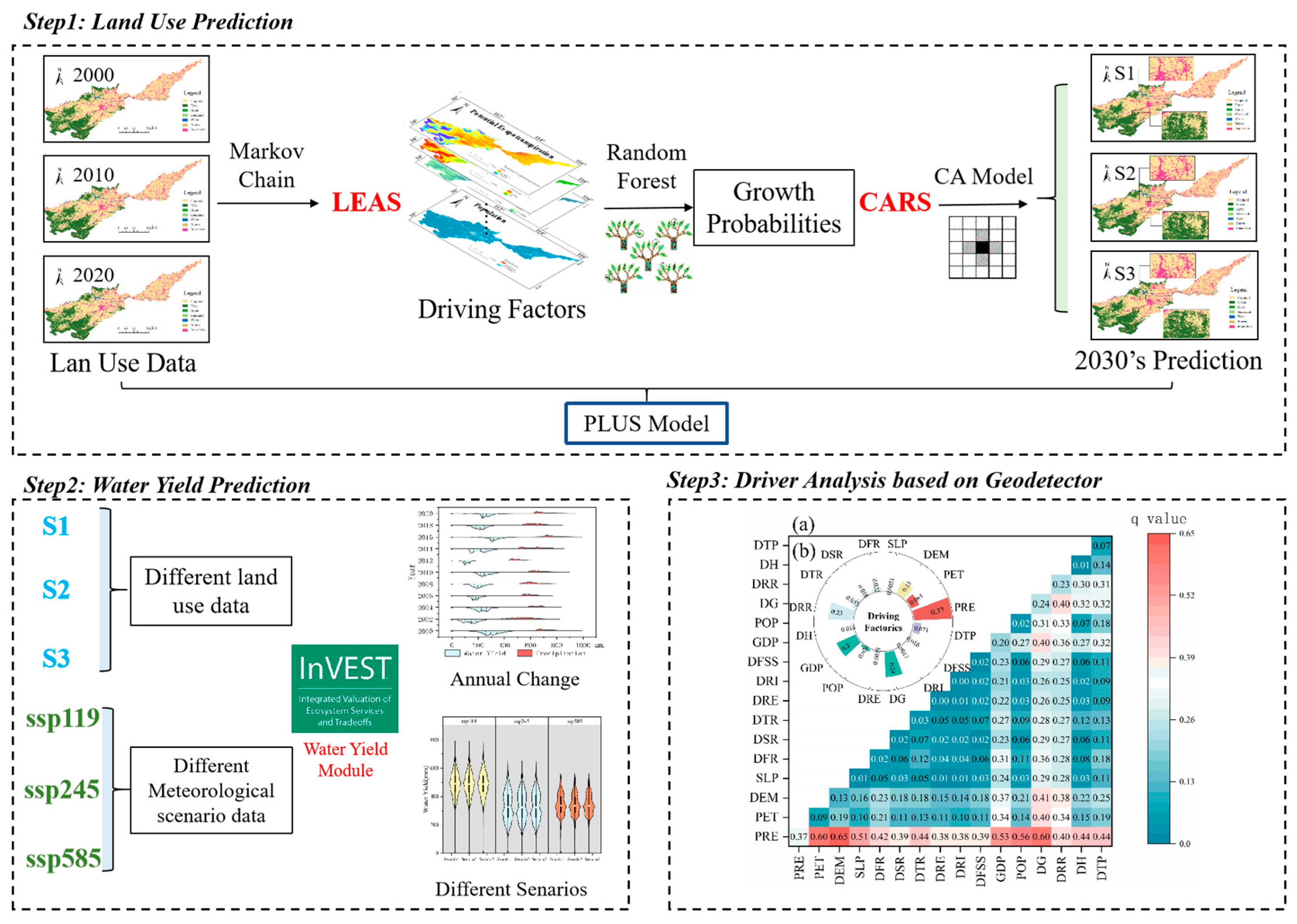


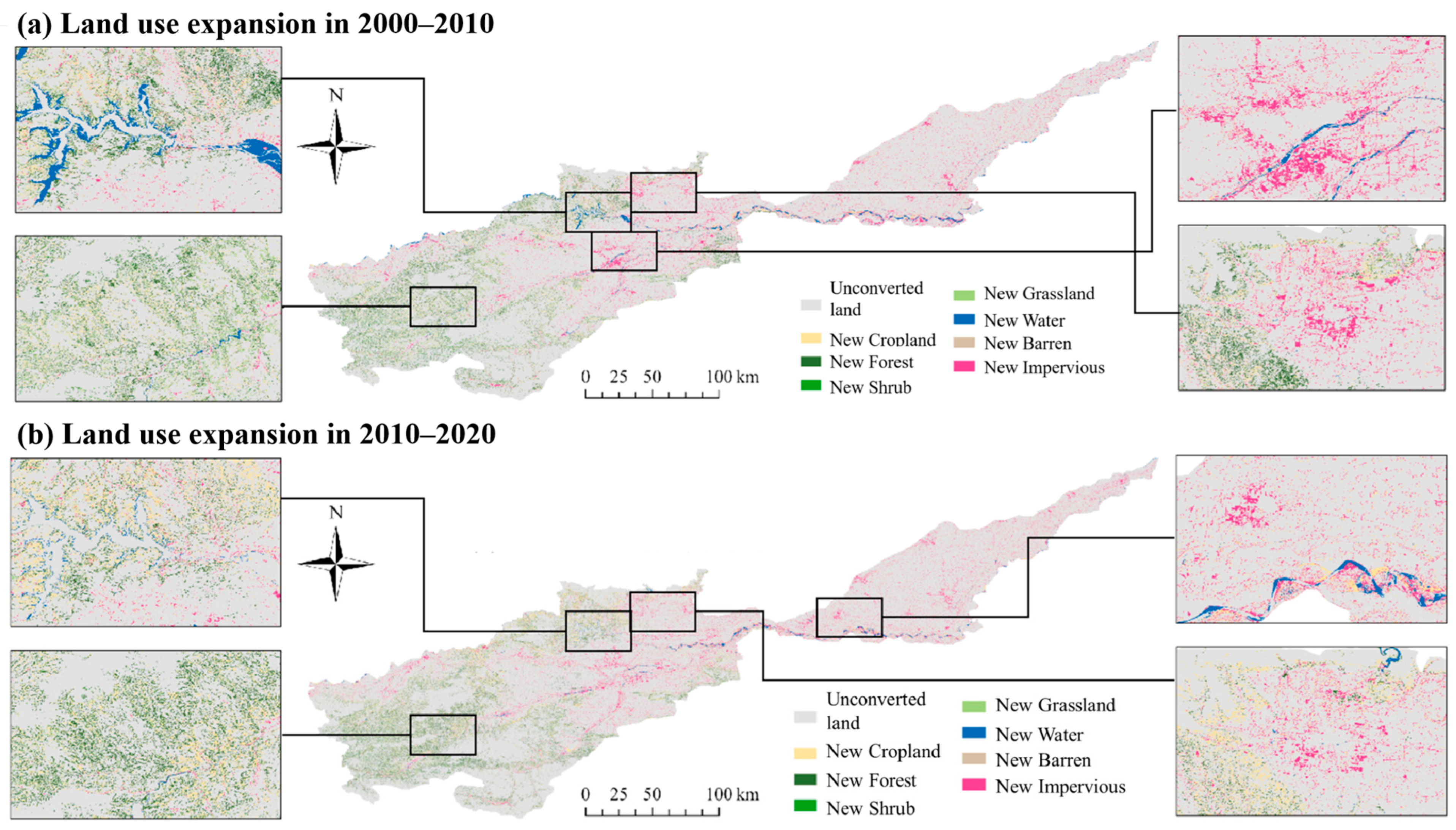
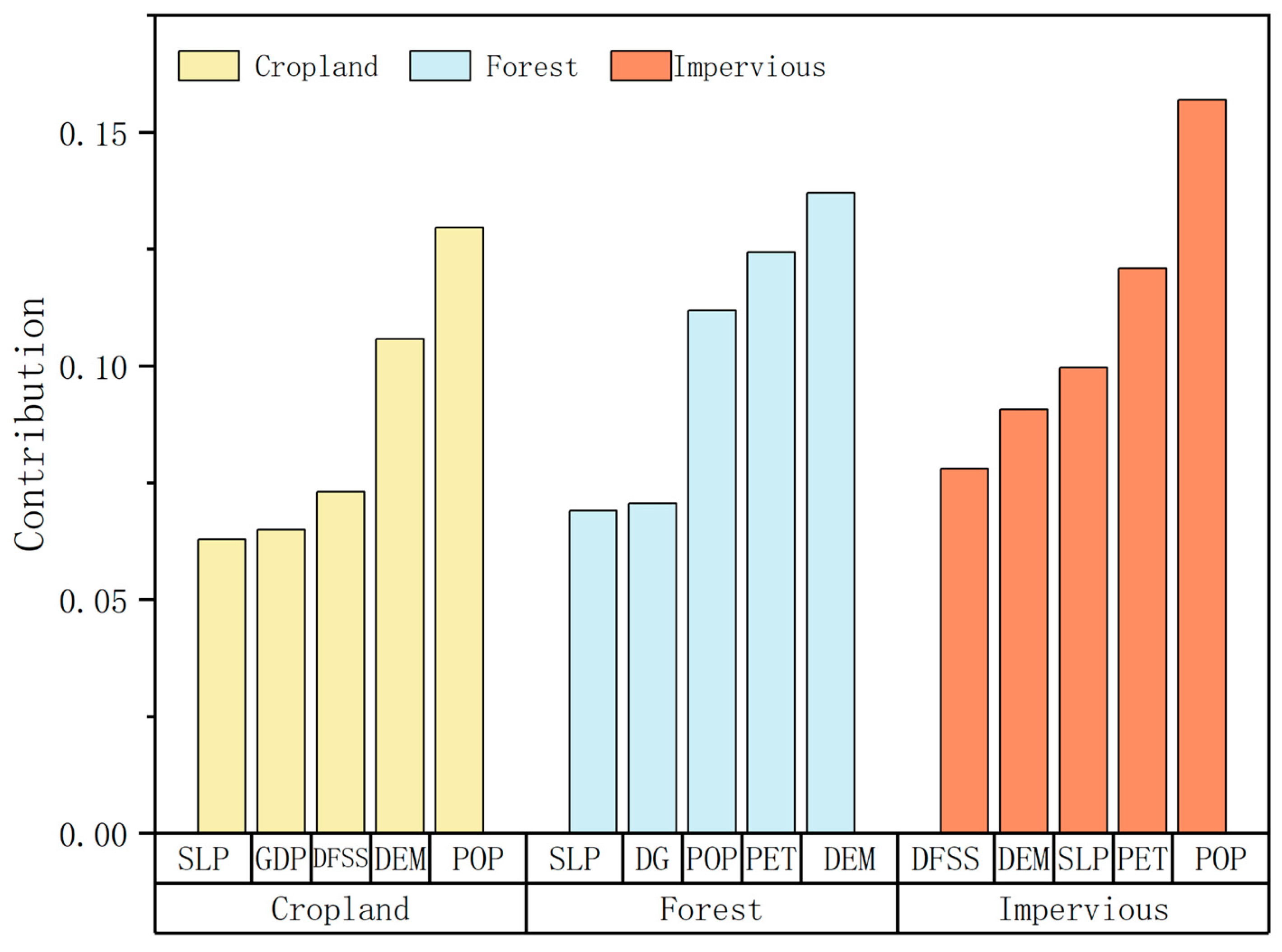


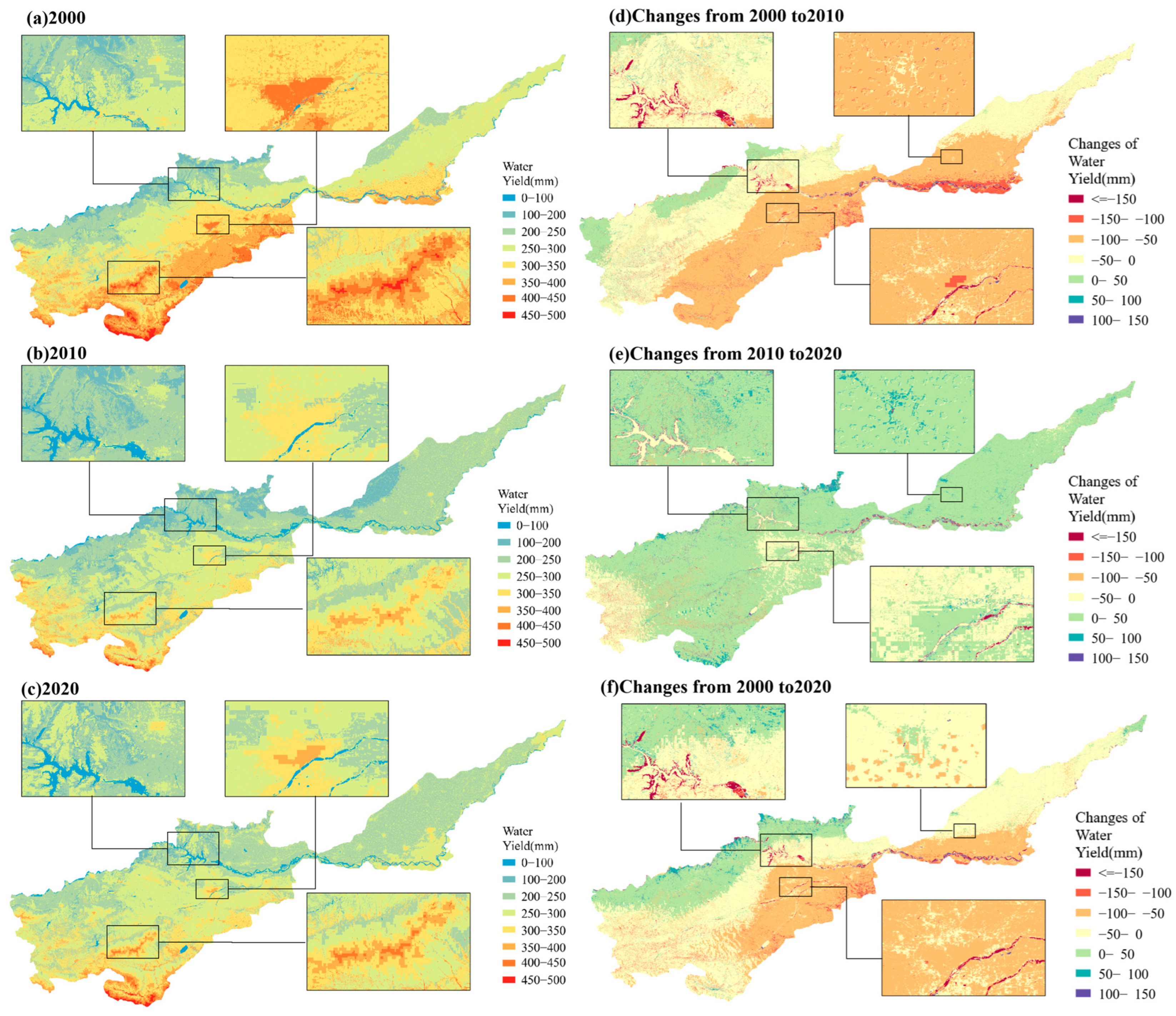

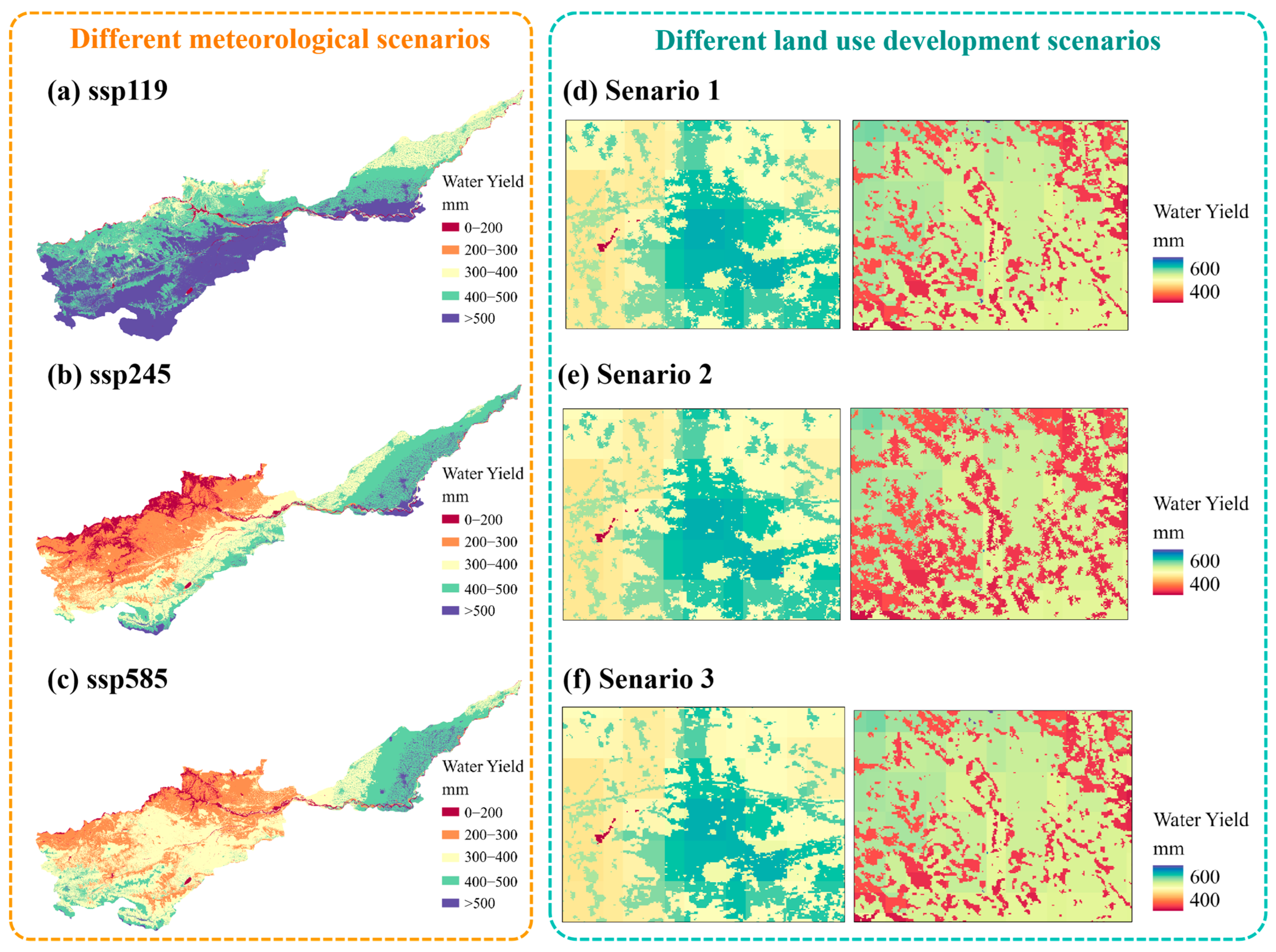

| Scenario 1 (Economic Development Priority) | Scenario 2 (Ecological Development Priority) | Scenario 3 (Cropland Development Priority) | |||||||||||||||||||
|---|---|---|---|---|---|---|---|---|---|---|---|---|---|---|---|---|---|---|---|---|---|
| a | b | c | d | e | f | g | a | b | c | d | e | f | g | a | b | c | d | e | f | g | |
| a | 1 | 1 | 0 | 1 | 0 | 0 | 1 | 1 | 1 | 0 | 1 | 0 | 0 | 1 | 1 | 0 | 0 | 0 | 0 | 0 | 0 |
| b | 1 | 1 | 0 | 0 | 0 | 0 | 1 | 0 | 1 | 0 | 0 | 0 | 0 | 0 | 1 | 1 | 0 | 0 | 0 | 0 | 0 |
| c | 0 | 1 | 1 | 1 | 0 | 0 | 1 | 0 | 1 | 1 | 1 | 0 | 0 | 0 | 1 | 1 | 1 | 1 | 0 | 0 | 0 |
| d | 0 | 1 | 1 | 1 | 0 | 0 | 1 | 0 | 1 | 1 | 1 | 0 | 0 | 0 | 1 | 1 | 1 | 1 | 0 | 0 | 0 |
| e | 0 | 0 | 0 | 0 | 1 | 0 | 1 | 0 | 0 | 0 | 0 | 1 | 0 | 1 | 1 | 0 | 0 | 0 | 1 | 0 | 1 |
| f | 0 | 0 | 0 | 1 | 1 | 1 | 1 | 1 | 1 | 0 | 1 | 1 | 1 | 1 | 1 | 0 | 0 | 1 | 1 | 1 | 1 |
| g | 0 | 0 | 0 | 0 | 0 | 0 | 1 | 0 | 0 | 0 | 0 | 0 | 0 | 1 | 0 | 0 | 0 | 0 | 0 | 0 | 1 |
| 2000 | 2020 | |||||||
|---|---|---|---|---|---|---|---|---|
| Cropland | Forest | Shrub | Grassland | Water | Barren | Impervious | Total | |
| Cropland | 19,483.1 | 821.0 | 0.5 | 177.1 | 198.0 | 0.7 | 1425.3 | 22,105.7 |
| Forest | 373.7 | 8147.9 | 3.1 | 23.1 | 0.4 | 0.0 | 13.1 | 8561.4 |
| Shrub | 6.4 | 120.8 | 20.4 | 27.3 | 0.0 | 0.0 | 0.1 | 175.0 |
| Grassland | 460.6 | 408.3 | 10.2 | 572.9 | 5.3 | 0.0 | 12.6 | 1469.9 |
| Water | 87.5 | 0.6 | 0.0 | 0.3 | 245.8 | 0.3 | 50.6 | 385.1 |
| Barren | 0.0 | 0.0 | 0.0 | 0.0 | 0.0 | 0.0 | 0.1 | 0.1 |
| Impervious | 32.2 | 0.0 | 0.0 | 0.8 | 87.3 | 0.5 | 2761.0 | 2881.8 |
| Total | 20,443.6 | 9498.7 | 34.2 | 801.5 | 536.7 | 1.5 | 4262.8 | |
| Cropland | Forest | Shub | Grassland | Water | Barren | Impervious | |
|---|---|---|---|---|---|---|---|
| 2020 | 20,470.70 | 9519.27 | 34.24 | 802.02 | 557.29 | 1.45 | 4270.42 |
| Predicted 2030 | 19,973.29 | 9698.21 | 24.30 | 701.39 | 540.32 | 0.11 | 4717.79 |
| Scenario 1 | 19,829.85 | 9518.90 | 34.23 | 800.58 | 544.06 | 1.09 | 4926.69 |
| Scenario 2 | 19,703.29 | 9968.21 | 24.08 | 665.36 | 546.64 | 1.14 | 4746.69 |
| Scenario 3 | 20,756.47 | 9454.37 | 24.08 | 594.34 | 540.32 | 0.69 | 4285.14 |
Disclaimer/Publisher’s Note: The statements, opinions and data contained in all publications are solely those of the individual author(s) and contributor(s) and not of MDPI and/or the editor(s). MDPI and/or the editor(s) disclaim responsibility for any injury to people or property resulting from any ideas, methods, instructions or products referred to in the content. |
© 2024 by the authors. Licensee MDPI, Basel, Switzerland. This article is an open access article distributed under the terms and conditions of the Creative Commons Attribution (CC BY) license (https://creativecommons.org/licenses/by/4.0/).
Share and Cite
Ma, X.; Liu, S.; Guo, L.; Zhang, J.; Feng, C.; Feng, M.; Li, Y. Evolution and Analysis of Water Yield under the Change of Land Use and Climate Change Based on the PLUS-InVEST Model: A Case Study of the Yellow River Basin in Henan Province. Water 2024, 16, 2551. https://doi.org/10.3390/w16172551
Ma X, Liu S, Guo L, Zhang J, Feng C, Feng M, Li Y. Evolution and Analysis of Water Yield under the Change of Land Use and Climate Change Based on the PLUS-InVEST Model: A Case Study of the Yellow River Basin in Henan Province. Water. 2024; 16(17):2551. https://doi.org/10.3390/w16172551
Chicago/Turabian StyleMa, Xiaoyu, Shasha Liu, Lin Guo, Junzheng Zhang, Chen Feng, Mengyuan Feng, and Yilun Li. 2024. "Evolution and Analysis of Water Yield under the Change of Land Use and Climate Change Based on the PLUS-InVEST Model: A Case Study of the Yellow River Basin in Henan Province" Water 16, no. 17: 2551. https://doi.org/10.3390/w16172551






